Milwaukee 21″ Self-Propelled Dual M18 Battery Mower
Milwaukee 21” Self-Propelled Dual Battery Mower 2822HD Review
Milwaukee 21" Self-Propelled Dual M18 Battery Mower
While the Milwaukee 21” mower is geared towards the professional landscaper it is worth a look for anyone who wants a very solidly built cordless battery-powered lawnmower, especially if they’re on the M18 battery platform.
Milwaukee introduced this mower with a high lift steel deck that mulches grass into finer pieces and provides a “Best-Cut” quality. In addition, they highlight a torque performance that is greater than a 200 cc gasoline mower. Since the 36v electric motor powers it, the blade reaches its full power and its top speed in under one second. So, we wanted to put this new equipment through its paces and see how it performed when pushed to the max.
TBB selected a lot that was overgrown with a combination of grasses, weeds, and whatever else nature grew in a plot of land at the front of one of our construction sites. We expect the Milwaukee 21” Self-Propelled mower will excel when mowing a well-manicured lawn. But how would it perform at an overgrown, rugged development parcel?
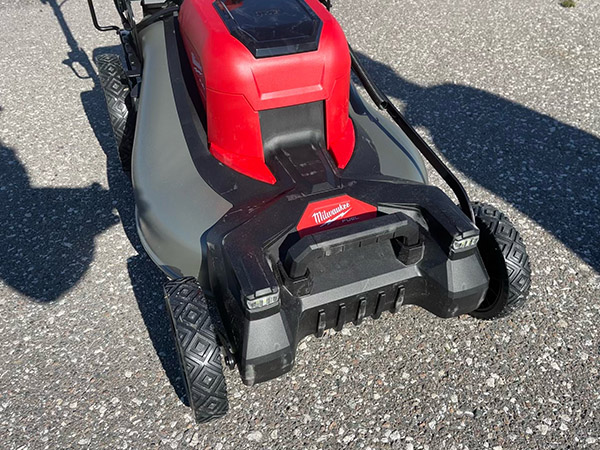
Milwaukee 21” Self-Propelled Dual Battery Mower 2822HD Kit with 2 Batteries 12.0 Ah
Specifications and Features
- Drive Type: – Rear-wheel drive self-propelled
- Deck size: 21″
- Commercial-grade steel deck
- Single point cut height adjustment delivers 1” – 4” deck height range in ½” increments
- No gas, emissions, oil mixing, or pull starts
- POWERSTATE™ Brushless motor delivers more torque than a 200-cc gas mower
- Self-propelled with variable speed adjustment wheel (0 MPH – 4 MPH)
- Variable Speed Selector and Active Speed Management Paddles to adjust walking speeds
- 2 bay battery compartment for 2 M18 Red Lithium High Output 12.0 Amp-hr. Batteries
- 3-in-1 design allows for mulching, bagging, or rear side discharge
- Front and Side LED lighting provides 180-degree visibility in low light
- 4 LED Battery fuel gauge faces operator during use
- Ergonomic Handle with recessed bail bar design
- Vertical storage capability
- Handle height adjusts to one of three handle heights
- Blade rotation speeds 2,800 – 3,300 RPM in High Lift Mode
- Grass catcher bag holds up to 2 bushels of grass
- Weight with supplied batteries – 85lbs
- Measured Noise level -77.9 dB no load on pavement 71.6 dB while mowing.
2823-22HD Kit Includes
- M18 FUEL™ 21″ Self-Propelled Dual Battery Mower (2823-20) (1)
- REDLITHIUM™ HIGH OUTPUT™ HD12.0 Battery Pack (48-11-1812) (2)
- Dual Bay Simultaneous Rapid Charger(48-59-1802) (1)
- Grass Bag (1)
- Mulch Plug (1)
- Rear Side Discharge Chute (1)
First Impressions | Milwaukee 21″ Battery Lawnmower
Unpacking and Assembly
Unpacking the mower and setting it up was extremely easy. The packing materials are top quality meaning that the shipping bumps and bruises did not reach the inner box and the mower arrived in perfect condition.
The assembly of the Milwaukee 2823-20 mower was simple. The instructions were clear and the entire process took less than 5 minutes from a loose set of parts to a finished and ready-to-go mower.
Manufactured Quality
While we were assembling the mower, we noted that the hardware and mower pieces were excellent in quality. The pieces fit together with no issues. We noted that even the bolts that hold the handle together showed a great deal of thought.
These bolts have a section of the threads machined out so that the user can know when the knob has been backed off a sufficient amount to enable the user to fold up the mower handle. The threads at the end capture the knob threads and ensure that the user can fold the handle and the knob does not fall off the end of \the bolt.
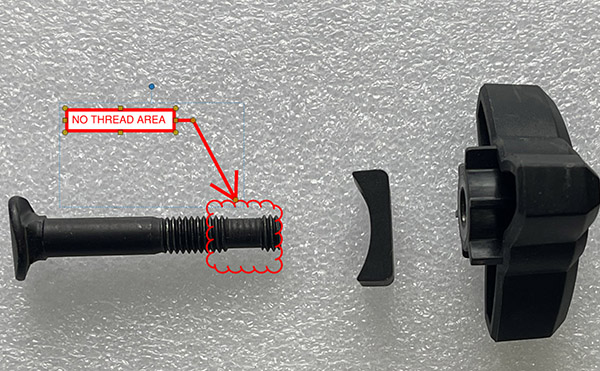
We tried the fit of the mulch plug, the rear side discharge chute, and the grass catcher. Each of these parts fit with no difficulty and we could easily install and remove.
We took a look at the underside of this mower and liked what we saw. First, we checked the wheels for run-out and felt no excess tolerances between the wheels and the axles. Unlike some of the competitors’ offerings, the Milwaukee precision is top-notch.
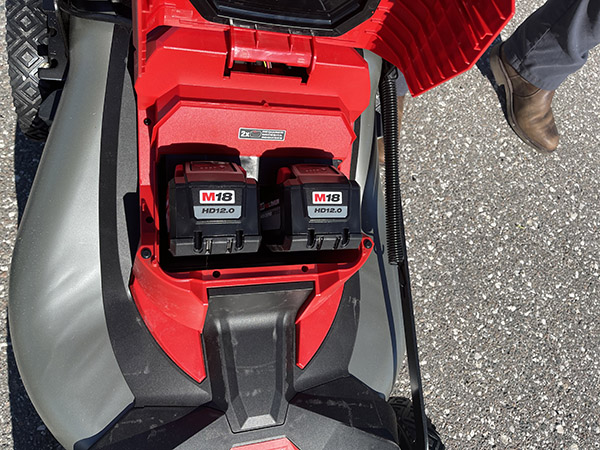
Another design element we liked was the front of the mower having what might best be described as a skid-plate-like design. The molded-in ridges should allow the mower to climb over debris and obstacles just like a skid plate works on a real off-the-road vehicle. Given that we were about to go mow down a rugged plot of land, we were glad to see this feature, knowing that the mower might have an easier time climbing over rough ground and over obstacles.
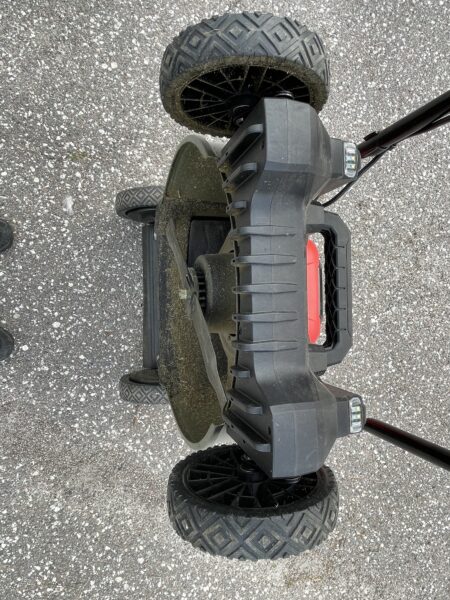
The Milwaukee has the look and feel of a mower that was built for daily nonstop use by professional landscapers In short, this high-quality Milwaukee mower is made for the long haul.
Controls and Adjustability
The Milwaukee 21” Self-Propelled Dual Battery mower is clearly targeted for the professional landscaper or owner that needs a high-quality lawn care mower. The 2823-20 is fully featured with all the controls that these applications require. The features are detailed and keyed to the diagram, below.
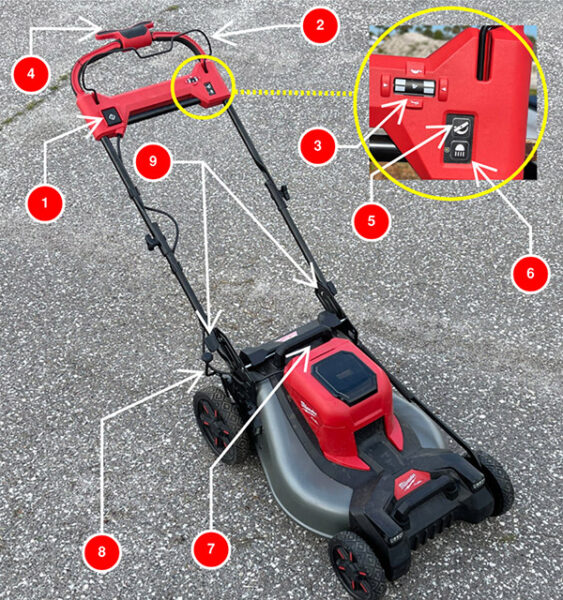
Start Blade Button
The switch is located on the operator’s right-hand side near the Safety bar. It is a large and well-positioned switch that stands out because of its size and white background. Users will get familiar with this control because the mower does no cutting until it is engaged. The bail bar must be held against the mower handle to keep the Start Switch depressed to start the blade motor. The Start Blade Button will remain locked inward as long as the Bail Bar is held down.
Safety Bail Bar
The user must engage the Bail Bar before the mower self-propulsion or blade motor will work. Milwaukee did a nice design job with integrating the Safety Bar into a recess in the mower handle. We used the mower extensively and did not even feel the Safety Bar during that time.
Self-Propel Speed Dial
This control sets the speed (from 1 – 5) that the mower will move. We recommend that the user set this at a relatively low setting and then increase the speed that is comfortable. The mower has a lot of torque and when the variable speed paddle is engaged, the mower will very quickly reach that speed and can startle a user or cause the user to lose control of the mower. The user can reset the Self-Propel Speed Dial while the mower is moving.
Variable Speed Self-Propel Paddle
Users can vary the speed of the mower with this control on a proportional basis. When it is fully depressed, the mower will reach the maximum setting on the Speed Dial. Users can also modulate the position of this Paddle to throttle the mower speed slower for going around obstacles or other reasons. Milwaukee designed this Paddle to be used by either hand and it works well even when one thumb is used. One feature of the Paddle is that it is available whenever the mower is powered. The blade does not need to be spinning to use the self-propelled feature.
High Lift Selector
High Lift mode increases the speed of the blade from 2800 rpm to 3300 rpm. Users may want to engage this mode for situations where Better bagging or finer mulching is needed. In the fall if the user wants to pick up leaves in the bag, the higher lift and faster blade speed will certainly assist in ensuring the lawn is clean after the mower makes a pass. Engaging the High Lift Mode will light up an LED next to the selector to remind the user that they selected this mode of operation.
LED Light Switch
For low light operations, users can turn on the headlights and sidelights to illuminate the surface to the front and sides of the mower. Toggling this switch will turn on and turn off these lights.
Fuel Gauge LED
Milwaukee put the LED Fuel Gauge for the battery status on the rear of the mower facing the operator. That way, they can see instantly the remaining amount of battery power. At full charge, all four LEDs illuminate. When the batteries reach one LED, the batteries are pretty well spent. However, When the juice is critically low, the remaining LED will flash. Shortly thereafter, under load, the mower will stop working. This LED cycle gives plenty of warning to prevent the user from being far away from the next set of charged batteries.
Blade Height Adjustment Lever
Milwaukee designed a single lever height adjustment to raise and lower the whole mower deck. The lever is located on the right side from the operator’s point of view. This lever moves the deck elevation from 1” above grade to 4” above grade. It has stops at ½” increments between the highest and lowest adjustment. Users can easily change between these stops by moving the lever out of a detent and positioning the lever to a new location. While it takes a bit more force to move the deck higher, the amount of effort required is small and easily accomplished.
Handle Height Locking Pins
Milwaukee’s designers provided three height positions for the mower handle. The lowest position places the heel of my hand at 36 ¼’ above ground. The middle adjustment puts my hand at 40 ½” above ground while the highest adjustment is 44 ¾”. I personally felt the highest setting is too tall for my comfort. I used the mower mostly at a medium height and was still comfortable on the lowest setting.
Getting lost in the weeds
During this first testing, we subjected this mower to conditions it may not have been designed to routinely undertake. Our test patch was on the other end of the spectrum from a finely manicured lawn and may have been better suited for a brush hog than a mower. We estimated that the grass was approximately 9” average height as gauged by the height when compared against a 5-gallon construction bucket.

When we used the side rear discharge chute, the mower resembled a hay bailer with the debris shooting out the side. Surprisingly, the mower did not bog down even when we cut down small bush-like growth and dense iron grass clumps.
The mower senses when the speed drops and almost instantly provides more power to compensate for the additional load. The user can hear the change in pitch when this happens. The mower recovery time to increase the speed is almost instantaneous.
First Cut
We started the test patch with the mower deck at 6 ½” high. That way, we could go through the highest grass and weeds and frankly miss anything that was concealed in the grass. We used the mulching plug for this cut to see if the mower would choke on the amount of material it was chewing up. It did not and cut through the materials with no trouble at a relatively high speed. Our typical speed on the first cut was between 3 ½ and 4. The first cut lasted ½ an hour and used one unit of power out of four
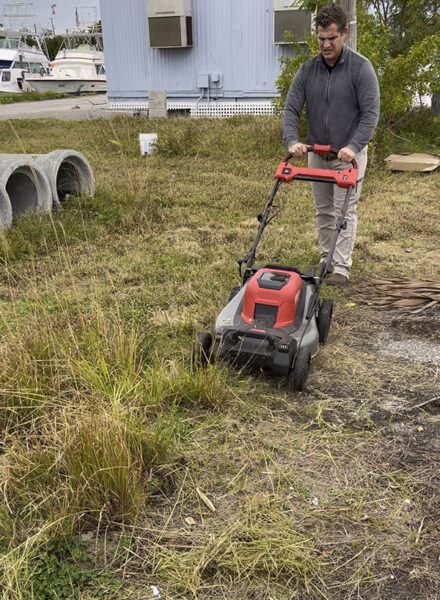
Second Cut
Once the initial cut was completed, we lowered the deck to a 2-inch height. We used the side rear discharge chute during the second cut and re-cut the plot of the ground. Again, the Milwaukee mower did not hesitate in slicing through the grasses. We took 20 minutes to complete the second cut and had one unit of power remaining. This portion of the test really challenged the mower, and we moved an impressive and large mass of grass material. Near the end of the second cut, we took a couple of areas and lowered the deck down to the lowest deck setting.
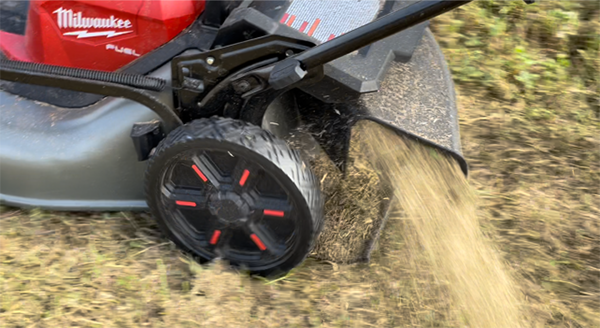
The Milwaukee mower went through this material and the old clippings with no issues. The only thing we noticed was that at one point in this test, the clippings stopped coming out of the chute. When we turned the mower over, we found a stick that lodged itself across the discharge chute and built up a plug of grasses that stopped the grass clipping discharge. The mower did not show any issues with this instant conversion to a mulching process. It was only apparent that nothing was coming out of the chute.
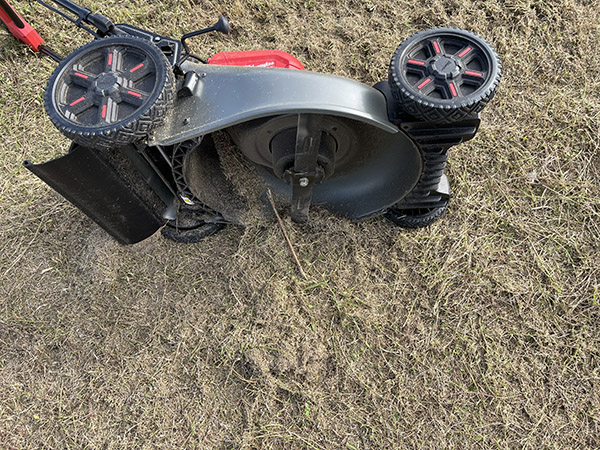
Final Cut
The final portion of the test was taking the mower to another part of the site and cutting a more conventional grass lawn to see how much longer the battery would run on one LED’s worth of power and how the mower would behave when we exhausted the batteries.
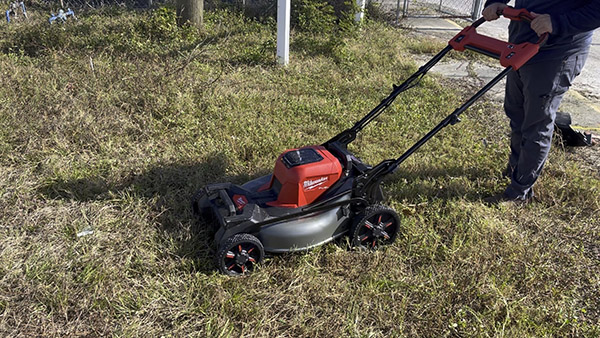
The mower lasted another 15 minutes in the remaining lawn area. We continued to use the side rear discharge chute as this represented the lightest load for the mower. When the batteries are nearly depleted, the single LED on the fuel gauge starts to flash to indicate the end of the power. While it was in this flashing state, we hit a dense patch of grass and the mower simply stopped. Lights out and no power.
In total, we used the mower for 65 minutes of torture testing time. Throughout that time, the Milwaukee mower had no difficulties with anything we asked it to cut. In the easier grass areas, we felt like the Milwaukee mower clearly outperformed a gasoline mower. It was much quieter, creates no exhaust fumes, and was as agile and easy to use as any mower we have ever used. Quite an impressive first experience.
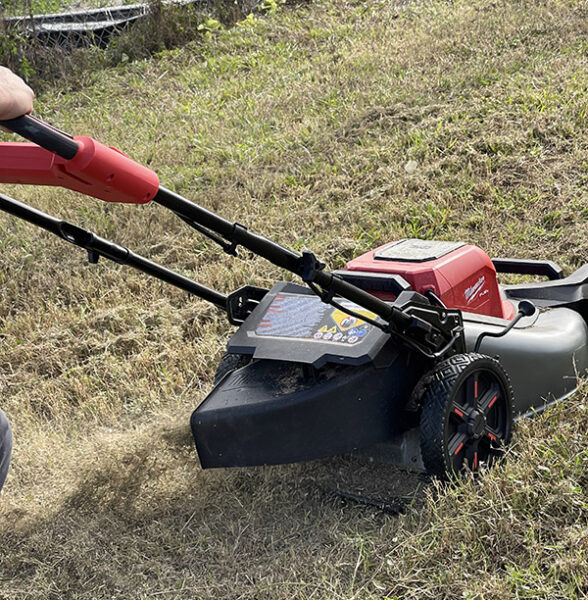
Noise
One of the biggest questions readers have asked about cordless mowers seems to be how much noise do they make?
We did a basic decibel test to measure the sound pressure of this mower to get an idea of how much noise it makes. The test consisted of running the mower with the deck raised to its midpoint level sitting on the asphalt slab in front of our construction trailer. We held the decibel meter at approximately user ear height. The decibel meter used an ITU-R 468 frequency rating.
We ran the test for thirty seconds – enough time to have the mower reach a maximum and stable rpm speed. The blade speed reaches a maximum rpm rate in less than one second. We extended the time to be consistent with the dB reading we took in our Cordless Mower Head-to-Head test in 2020. That way, we could see how Milwaukee stacked up.
Readings
The Milwaukee registered an average reading of only 77.9 dB on asphalt – about the same amount of noise as one experiences when a car passes at 65mph. The noise we measured while mowing averaged 71.6 dB which is a reduction of approximately 40% in noise energy from the reading on the asphalt. The Milwaukee mower was quieter than any of the mowers in our 2020 Cordless Mower Head-to-Head by2.5dB.
This mower is very quiet. Your neighbors may not even know you are cutting your lawn when they are inside their homes.
Note that both of these sound levels are well below the OSHA limit requiring hearing protection over a period of an 8-hour shift. That is one reason our operator did not wear any hearing protection.
Comparison
For reference, the average gas lawnmower produces approximately 95 – 100 dB. Compared to a 100 dB noise level, the Milwaukee 2823-20 mower at 78.9dB reduces the sound intensity energy you hear by over 100 times compared to a loud gas mower. (Decibels are a logarithmic scale, 14 decibels difference is approximately 20 times louder). Many communities in our area have adopted noise restrictions that limit the time that you can mow with a gas mower. Please note that the sound pressure value was measured while running on top of an asphalt slab. In practice, the Milwaukee mower was much quieter when used on a lawn.
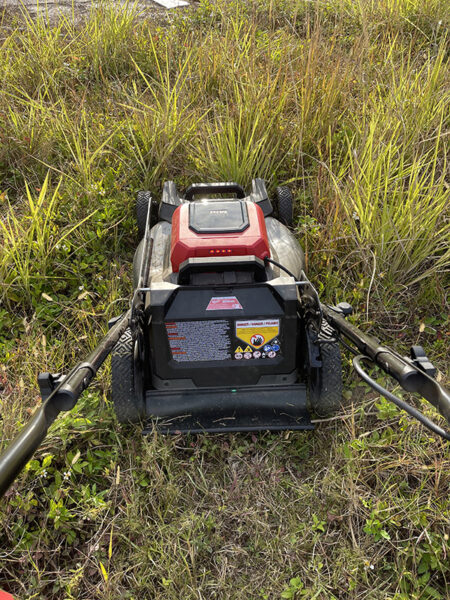
Storage and Transport
Milwaukee’s engineers and designers produced a mower for the pro-market. To this end, Milwaukee’s handle stores best vertically with the handle in a straight configuration. Pro landscapers are all about efficiency and speed, so a folding handle is usually a negative feature as that keeps them from getting on and off the job more quickly. Homeowners may want to take the time to fully fold the handle as they typically have a good amount of space. I personally don’t want to fiddle with a folding handle and would keep the handle straight.
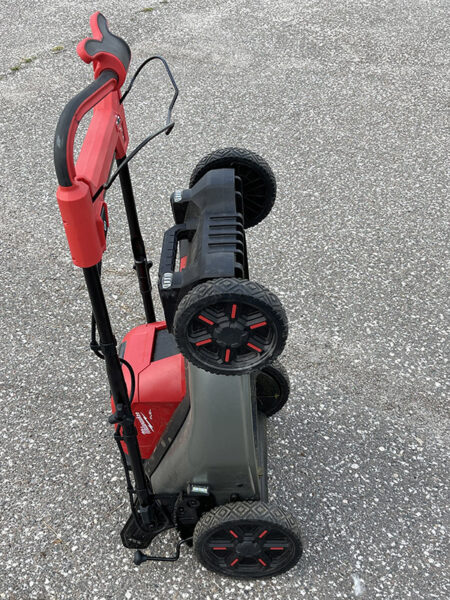
One well-thought-out feature of this mower is the big handles on the front of the deck and the back of the mower. Allowing it to be easily picked up and put in the back of a truck or trailer. The Milwaukee mower is no lightweight piece of equipment, and the two handles make it much easier to lift.
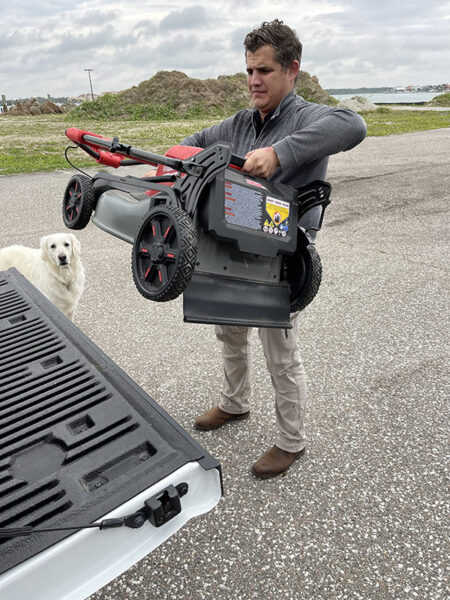
Overall
This is a great mower designed and built with the professional in mind and the quality/price reflects an excellent value. The Milwaukee M18 Fuel™ 21” Self-Propelled mower is an impressive OPE tool and will stack up well against its competition.
I was one of the leads in the Toolbox Buzz 2020 Cordless Mower Head-to-Heat that we published in June of 2020. In comparing this Milwaukee to the results I saw in that H-2-H, the Milwaukee 21” mower would have killed it in many of the critical categories we reviewed. I would stack this mower up against the top finishers from that comparison.
I am glad Milwaukee produced a compelling offering in this market. Great job.
Kit pricing will be $999.00 with a product availability of April 2022.
Milwaukee Milwaukee 21" Self-Propelled Dual M18 Battery Mower
Buy Now From Our Sponsored Retailers
Milwaukee 21” Self-Propelled Dual Battery Mower 2822HD Video Review
About the author
5 Comments
Leave a comment
Disclosure
Product reviews on this site contain our opinion of a product or service. We will always strive for objectivity and transparency in our reviews. Our goal is to provide readers with honest, objective information based on our own experiences. We never have and never will accept payment in exchange for a positive review. Many of the products that we review are provided to us for free by a manufacturer or retailer. In some cases, we also have advertising or affiliate relationships with manufacturers and retailers of products and services we review. For additional information please visit our additional disclosure policies.























Love this mower! Can’t wait for it to become available! Seems like it will be a fantastic unit for me and I’ve been waiting for this for years!
I was very impressed nd I think you will be pleased by its quality and performance.
really great
Very Nice Moyer, but $999.00..Mercy….
You can get the EGO Machine which is 56 volts for 1/2 the price..When you are 72 years old & retired, this machine does not seemto be for the ‘avarage’ guy.
Voltage doesn’t really mean anything, power is a combination of voltage and amperage, and Milwaukee typically has a stupid amount of amperage. It makes it more expensive to engineer at lower voltages, but the total output is actually better.